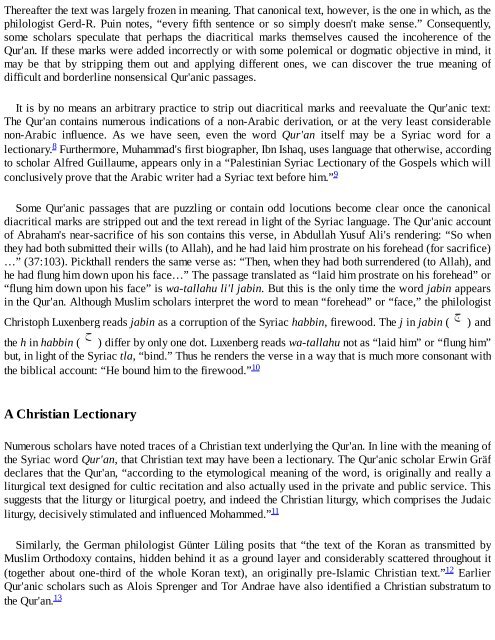robert spencer-did muhammad exist__ an inquiry into islams obscure origins-intercollegiate studies institute (2012) (1)
Create successful ePaper yourself
Turn your PDF publications into a flip-book with our unique Google optimized e-Paper software.
Thereafter the text was largely frozen in me<strong>an</strong>ing. That c<strong>an</strong>onical text, however, is the one in which, as the<br />
philologist Gerd-R. Puin notes, “every fifth sentence or so simply doesn't make sense.” Consequently,<br />
some scholars speculate that perhaps the diacritical marks themselves caused the incoherence of the<br />
Qur'<strong>an</strong>. If these marks were added incorrectly or with some polemical or dogmatic objective in mind, it<br />
may be that by stripping them out <strong>an</strong>d applying different ones, we c<strong>an</strong> discover the true me<strong>an</strong>ing of<br />
difficult <strong>an</strong>d borderline nonsensical Qur'<strong>an</strong>ic passages.<br />
It is by no me<strong>an</strong>s <strong>an</strong> arbitrary practice to strip out diacritical marks <strong>an</strong>d reevaluate the Qur'<strong>an</strong>ic text:<br />
The Qur'<strong>an</strong> contains numerous indications of a non-Arabic derivation, or at the very least considerable<br />
non-Arabic influence. As we have seen, even the word Qur'<strong>an</strong> itself may be a Syriac word for a<br />
lectionary. 8 Furthermore, Muhammad's first biographer, Ibn Ishaq, uses l<strong>an</strong>guage that otherwise, according<br />
to scholar Alfred Guillaume, appears only in a “Palestini<strong>an</strong> Syriac Lectionary of the Gospels which will<br />
conclusively prove that the Arabic writer had a Syriac text before him.” 9<br />
Some Qur'<strong>an</strong>ic passages that are puzzling or contain odd locutions become clear once the c<strong>an</strong>onical<br />
diacritical marks are stripped out <strong>an</strong>d the text reread in light of the Syriac l<strong>an</strong>guage. The Qur'<strong>an</strong>ic account<br />
of Abraham's near-sacrifice of his son contains this verse, in Abdullah Yusuf Ali's rendering: “So when<br />
they had both submitted their wills (to Allah), <strong>an</strong>d he had laid him prostrate on his forehead (for sacrifice)<br />
…” (37:103). Pickthall renders the same verse as: “Then, when they had both surrendered (to Allah), <strong>an</strong>d<br />
he had flung him down upon his face…” The passage tr<strong>an</strong>slated as “laid him prostrate on his forehead” or<br />
“flung him down upon his face” is wa-tallahu li'l jabin. But this is the only time the word jabin appears<br />
in the Qur'<strong>an</strong>. Although Muslim scholars interpret the word to me<strong>an</strong> “forehead” or “face,” the philologist<br />
Christoph Luxenberg reads jabin as a corruption of the Syriac habbin, firewood. The j in jabin (<br />
the h in habbin ( ) differ by only one dot. Luxenberg reads wa-tallahu not as “laid him” or “flung him”<br />
but, in light of the Syriac tla, “bind.” Thus he renders the verse in a way that is much more conson<strong>an</strong>t with<br />
the biblical account: “He bound him to the firewood.” 10<br />
) <strong>an</strong>d<br />
A Christi<strong>an</strong> Lectionary<br />
Numerous scholars have noted traces of a Christi<strong>an</strong> text underlying the Qur'<strong>an</strong>. In line with the me<strong>an</strong>ing of<br />
the Syriac word Qur'<strong>an</strong>, that Christi<strong>an</strong> text may have been a lectionary. The Qur'<strong>an</strong>ic scholar Erwin Gräf<br />
declares that the Qur'<strong>an</strong>, “according to the etymological me<strong>an</strong>ing of the word, is originally <strong>an</strong>d really a<br />
liturgical text designed for cultic recitation <strong>an</strong>d also actually used in the private <strong>an</strong>d public service. This<br />
suggests that the liturgy or liturgical poetry, <strong>an</strong>d indeed the Christi<strong>an</strong> liturgy, which comprises the Judaic<br />
liturgy, decisively stimulated <strong>an</strong>d influenced Mohammed.” 11<br />
Similarly, the Germ<strong>an</strong> philologist Günter Lüling posits that “the text of the Kor<strong>an</strong> as tr<strong>an</strong>smitted by<br />
Muslim Orthodoxy contains, hidden behind it as a ground layer <strong>an</strong>d considerably scattered throughout it<br />
(together about one-third of the whole Kor<strong>an</strong> text), <strong>an</strong> originally pre-Islamic Christi<strong>an</strong> text.” 12 Earlier<br />
Qur'<strong>an</strong>ic scholars such as Alois Sprenger <strong>an</strong>d Tor Andrae have also identified a Christi<strong>an</strong> substratum to<br />
the Qur'<strong>an</strong>. 13


